埋于非饱和土中的地下钢管道轴向特性研究
IF 6.7
1区 工程技术
Q1 CONSTRUCTION & BUILDING TECHNOLOGY
引用次数: 0
摘要
在野外条件下,地下管道周围的土壤往往是非饱和的。然而,非饱和条件对管道与土壤轴向相互作用的影响尚不清楚,目前的设计指南中没有考虑到这一点。这种限制可能导致不安全的设计,因为从潜在移动的土壤到管道的负荷可能被低估。为了解决这一问题,进行了六次大规模物理模拟试验,研究了埋在饱和和非饱和完全分解花岗岩(CDG)中的粗钢管的拔管行为。通过改变初始含水量来调节管道周围的基质吸力(0 ~ 70.2 kPa),并使用张力计进行测量。结果表明,在一定名义覆盖层压力下,轴向抽拔阻力随吸力增大而增大。在吸力为70.2 kPa时,阻力是饱和状态下的1.69倍,突出了当前设计指南中的重大风险。轴向阻力增量的68%归因于土-管界面液体半月板毛细力引起的附加界面接触压力。其余32%与净界面接触压力增加有关,主要是由于吸力对约束剪胀的影响。基于弹性膨胀柱体理论,考虑吸力对Bishop应力、刚度和剪胀率的影响,建立了非饱和条件下轴向阻力的简单计算模型。本文章由计算机程序翻译,如有差异,请以英文原文为准。
Axial behaviour of underground steel pipeline buried in unsaturated soils
Soils surrounding underground pipelines are often unsaturated in field conditions. However, the effects of the unsaturated condition on the axial interaction between pipelines and soils are unclear and not considered in current design guidelines. This limitation may lead to unsafe designs, as the load from potentially moving soil to pipelines could be underestimated. To address this, six large-scale physical modeling tests were conducted to examine pipe pullout behavior using a rough steel pipe buried in saturated and unsaturated completely decomposed granite (CDG). Matric suctions around the pipe (0 ∼ 70.2 kPa) were adjusted by varying the initial water content and measured using tensiometers. The results show that axial pullout resistance, under constant nominal overburden pressure, increases with suction. At a suction of 70.2 kPa, the resistance was 1.69 times greater than in the saturated condition, highlighting significant risks in current design guidelines. 68 % of this axial resistance increment is attributed to the additional interface contact pressure induced by capillary forces of soil-pipe interface liquid menisci. The remaining 32 % is related to net interface contact pressure increases mainly due to suction effects on constrained dilatancy. A new and simple model was developed for calculating axial resistance in the unsaturated condition, based on elastic expanding cylinder theory, considering suction effects on Bishop’s stress, stiffness, and dilatancy.
求助全文
通过发布文献求助,成功后即可免费获取论文全文。
去求助
来源期刊

Tunnelling and Underground Space Technology
工程技术-工程:土木
CiteScore
11.90
自引率
18.80%
发文量
454
审稿时长
10.8 months
期刊介绍:
Tunnelling and Underground Space Technology is an international journal which publishes authoritative articles encompassing the development of innovative uses of underground space and the results of high quality research into improved, more cost-effective techniques for the planning, geo-investigation, design, construction, operation and maintenance of underground and earth-sheltered structures. The journal provides an effective vehicle for the improved worldwide exchange of information on developments in underground technology - and the experience gained from its use - and is strongly committed to publishing papers on the interdisciplinary aspects of creating, planning, and regulating underground space.
 求助内容:
求助内容: 应助结果提醒方式:
应助结果提醒方式:


